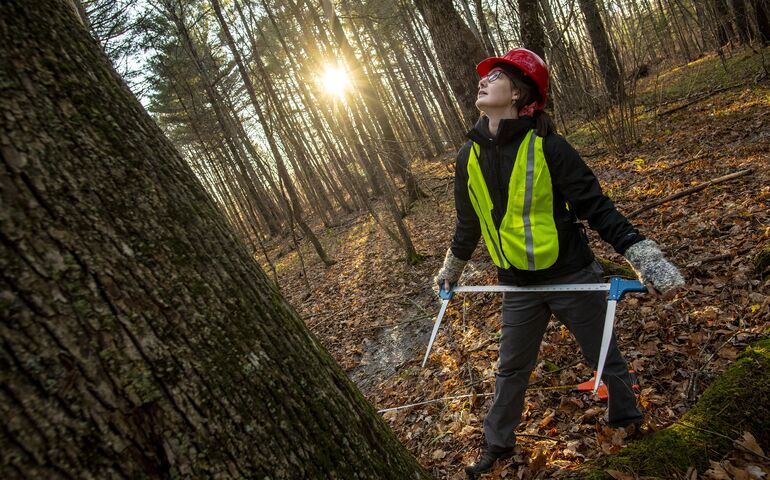Gender gap in Maine forestry closes — a little
 Courtesy / University of Maine
A new study shows that women are gaining ground in the forestry profession a bit, but have further to go. Here, a University of Maine student conducts research in Demeritt Forest adjacent to the Orono campus.
Courtesy / University of Maine
A new study shows that women are gaining ground in the forestry profession a bit, but have further to go. Here, a University of Maine student conducts research in Demeritt Forest adjacent to the Orono campus.
A growing number of women are entering Maine’s forestry industry. But a new study finds there are still plenty of leaks in the industry's education-to-employment pipeline.
Mindy Crandall, a former UMaine assistant professor of forest landscape management, co-authored the study “An Adaptive and Evidence-Based Approach to Building and Retaining Gender Diversity within a University Forestry Education Program: A Case Study of SWIFT,” which was published last month.
The study found that, in Maine, just 8% of licensed foresters, or 52 of 680, are women, despite an effort begun in 2016 to increase that ratio.
In 2016, a group of female University of Maine faculty and students concerned about the low number of women graduating from UMaine with bachelor’s degrees in forestry formed a group called Supporting Women in Forestry Today, or SWIFT.
The goal was to increase and retain the number of women in forestry, from education to employment.
Crandall studied SWIFT’s work to date and found that women encountered an unwelcoming climate, the perception that forestry is a “male” profession, a lack of a sense of belonging, and a perceived dearth of opportunities.
But in a survey of women in the UMaine School of Forest Resources, respondents reported that SWIFT had helped them feel more aware, connected, confident, and equipped to recognize and respond to bias and discrimination.
Enrollment of women in the School of Forest Resources has increased since 2009, and women accounted for 43% of the school's graduate students in 2010-19. Most did not have an undergraduate forestry degree.
In 2014, there were no female graduates from the school, and in 2009 and 2016 there was only one.
The lack of an undergraduate forestry degrees among women could be rooted in that fact that there are few visible role models, Crandall said. UMaine had one tenure-track female faculty member within its Society of American Foresters’ accredited forestry program between 1981 and 2006, and none from 2006 to 2014.
Still, the study provided evidence that small-scale groups like SWIFT can spur positive changes for women in forestry, Crandall said.
SWIFT hosts events and coordinates other activities each academic year to create an inclusive environment for women in the field.
Educational readings, discussions, panel sessions, social events and hands-on training showed promise as ways to effectively engage women in the forestry profession and increase the likelihood they will complete the program and join the workforce, said Crandall, who is now an assistant professor at Oregon State University.













0 Comments